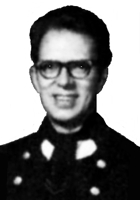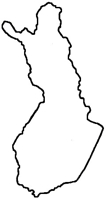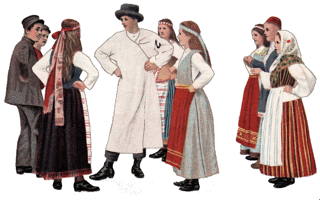
|
The Society of Folk Dance Historians (SFDH)
Folk Music and Dance of Finland
[
Home |
About |
Encyclopedia | CLICK AN IMAGE TO ENLARGE |

|
 As Finland is a bi-lingual country, it also is a bi-cultural one. Of Finland's nine provinces, four are considered bi-lingual. They are the provinces of Östernbotten (Pohjanmaa), Åland (Ahvenanmaa), Aboland or Egentliha Finland (Turunmaa or Varsinais-Suomi), and Nyland (Uusimaa).
As Finland is a bi-lingual country, it also is a bi-cultural one. Of Finland's nine provinces, four are considered bi-lingual. They are the provinces of Östernbotten (Pohjanmaa), Åland (Ahvenanmaa), Aboland or Egentliha Finland (Turunmaa or Varsinais-Suomi), and Nyland (Uusimaa).
The Finnish-Swedish fiddlers are organized in an association, "Finlands Svenska spelmansöbund," which in 1970 started to publish a members' newsletter, "Fiolen min" (My fiddle). The highlights of their activities are the annual fiddlers' festival, "Riksspelmansstämma," and the triennial folk dance and fiddlers' festival, "Nordlek." Several records of Finnish-Swedish folk music have been pressed.
The pure Finnish fiddlers are organized in two associations, "Suomen pelimanniyhdistys (SPY)," (from "Pelimanni;" "Fiolen min") and "Suomen pelimannikilta." In December 1969, the former association started to publish a newsletter, "Pelimanni." SPYs annual schedule is a very heavy one. Suomen pelimannikilta has a membership of 2,000 fiddlers.
Very little is known of the folk music that existed in Finland a few hundred years ago. One can assume that there already existed "lockrop" and shepherds' songs like those that one can still hear at the beginning of the century. It is also evident that they had different kinds of working songs and lullabies, as well as ballads and love songs. Musical instruments were used at ritual ceremonies as well as at dances. They blew in pipes, on birch bark horns, and on animal horns. Besides playing the plucking instrument, "kantele (a ten string zither)," they also played the "stråkharpa (or "Talharpa," a four-stringed bowed lyre)."
The "jojker" (a bagpipe's "chanter" that can be blown directly from the mouth) and the drums of the Lapps are a chapter of their own. One can speak of a westerly and an easterly tradition.
 Only at the end of the 18th century did they start to annotate folk melodies. This work picked up speed among the pure Finns as well as among the Finnish-Swedes only during the latter half of the 19th century. Some of the material that was retained has its roots in older periods. This concerns mainly the epic songs that are now called ballads.
Only at the end of the 18th century did they start to annotate folk melodies. This work picked up speed among the pure Finns as well as among the Finnish-Swedes only during the latter half of the 19th century. Some of the material that was retained has its roots in older periods. This concerns mainly the epic songs that are now called ballads.
The bulk of the collected tunes were comparatively new. The were usually performed by violin or clarinet. These instruments became common in Finland in the 18th century. Most of the melodies in question are dance melodies. "Menuets," "Polskas," and "Polonaises" represent the dance music of the 18th century and in places, among others in Österbotten," still in our century. The Waltz, Polka, Schottische, and Mazurka came to Finland during the 19th century.
Much has been saved for posterity, but much has been lost. Regrettably, there were no tape recorders in the 19th century. The lack of experienced annotators of melodies was also great.
As regards the origin, it can be said that the retained fiddle music largely is derived from the nobility. Naturally, melodies have been created by the countryfolk's own fiddlers, but these melodies are usually heavily influenced by the Menuet, Polska, Waltz, and other dance melodies that spread from the aristocratic salons to the farmhouses. The folk music has then to some extent been a recipient, but it also has as a giver, influenced the artistic music since the dawn of the romanticism at the beginning of the 19th century.
The greater part of the repertoire of the pure Finnish and Finnish-Swedish fiddlers consists of melodies from the 19th and the beginning of the 20th centuries, that is, Waltzes, Polkas, Schottisches, and Mazurkas, as well as wedding melodies. Here and there they link to the traditions of the 18th century by playing Menuets and Polskas.
In addition to fiddles, the accordion, which was invented in the 1820s, has achieved a prominent position. Bass-fiddles, drums, and other instruments, strangers to the old folk music are being used. Among the pure Finns, the "harmoniet" (or "harmonium," pump organ) has gained popularity as a harmonious accompanying instrument.
A systematic collecting of the traditions of the Finnish-Swedish country-folk was started in the 1840s. One of the forerunners of this work was Johan Oscar Immanuel Rancken (1824-1895), who then was senior teacher in Swedish at Vasa Gymnasium. During classes at school, Rancken was trying to interest his pupils in the folk poetry and the traditions of their home regions. Rancken himself wandered around in the countryside annotating songs and dances. Many of his pupils became arden collectors. The most prominent of these was Jakob Wefvar (1840-1911). In his collection of folk songs and singing games there are about 1,500 entries. In addition he has annotated about 600 melodies.
The Brage association was formed in 1906 by Otto Andersson (1879-1969). Its main purpose is to preserve and to enliven the various products of the folk arts, that is, folk poetry, folk music, folk dance, and costumes. In the spring of 1908, Otto was in Berlin, where he became acquainted with the phonograph and realized its great potential for folk music research. In 1909, a phonograph archive was set up at Brage, and a phonograph accompanied Otto thereafter on many of his field trips. It is not only the fiddlers' tunes that he managed to save for posterity but he always carried a camera and thanks to him, many of the fiddlers are recorded in the Brage collections.
Professor Andersson not only collected and annotated the material, but he also prepared and published a large portion of it. In the series, "Finlands Svenska folkdiktning" (Finland's Swedish folk poetry), he has published four volumes: "Den äldre folkvisan" (The older folk song); "Sänglekar" (Singing games); "Äldre dansmelodier" (The older dance tunes); and "Br&#$241;llopsmusik" (Wedding music). Professor Andersson also worked to make the folk songs known. He, among other things, arranged songs for choirs.
The Finnish-Swedish folk dances are annotated in three books available as of 1976:
- "45 Folkdanser" – descriptions and musical notes (in Swedish).
- "Instruktionshäfte 1" – 10 Finnish-Swedish folk dances, descriptions, and musical notes (in Swedish).
- "Instruktionshäfte 2" – 10 Finnish-Swedish folk dances, descriptions, and musical notes (in Swedish).
The pure Finnish folk dances are annotated in one book, also available as of 1976:
- "Kisapirtti" – 125 Finnish folk dances, descriptions, and musical notes (in Finnish).
A new book, "Suuri Tanhukirja" was in the making as of 1976.
The Finnish-Swedish folk dancers are organized in an association, "Finlands Svenska folkdansring r.f.," with head offices at Kaserngatan 40 C, Helsingfors, Finland. They have a membership of 2,000 dancers. Their newslatter is called "Folkdansaren."
The pure Finnish folk dancers are organized in three associations: "Suomalaisen kansantanssin ystävat r.y., (SKY)" with its head office at Mechelininkatu 36, Helsinki; "Suomen nuorison liitto (SNL)," and Kalevan nuorten liitto (KNL)," both with head office at Simonkatu 12 B 13, Helsinki. Suomen nourison liitto has many other activities besides folk dancing in its program. This applies also to Kalevan nuourten liitto, which is an association for youth, fifteen years old and younger. The SKYs newsletter is called "Tanhuviesti." The SNLs and the KNLs combined newsletter is called "Nuortensanomat."
The present folk dance consists of regular club activity, instructors' workshops or seminars, concerts, festivals of various kinds, and contests.
Summertime in Helsingfors (Helsinki); at Ånttigarden (Antin talolla); Folison (Seurassari); there are folk dance performances Tuesdays, Thursdays, Fridays, Saturdays, and Sundays by local or visiting groups. In addition, Finnish folk dancing is taught to the general public at the festival field on Fölisön (Seurasaari) on Thursdays and Sundays.
DOCUMENTS
- Finland, a country.
- Scandinavia, a region.
Used with permission of the author.
Printed in Folk Dance Scene, June 1976.
This page © 2018 by Ron Houston.
Please do not copy any part of this page without including this copyright notice.
Please do not copy small portions out of context.
Please do not copy large portions without permission from Ron Houston.